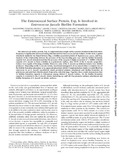Mostrar el registro sencillo del ítem
The enterococcal surface protein, Esp, is involved in Enterococcus faecalis biofilm formation
| dc.creator | Toledo Arana, Alejandro | es_ES |
| dc.creator | Valle Turrillas, Jaione | es_ES |
| dc.creator | Solano Goñi, Cristina | es_ES |
| dc.creator | Arrizubieta Balerdi, María Jesús | es_ES |
| dc.creator | Cucarella, Carme | es_ES |
| dc.creator | Lamata, Marta | es_ES |
| dc.creator | Amorena Zabalza, Beatriz | es_ES |
| dc.creator | Leiva, José | es_ES |
| dc.creator | Penadés, José R. | es_ES |
| dc.creator | Lasa Uzcudun, Íñigo | es_ES |
| dc.date.accessioned | 2019-01-10T08:27:59Z | |
| dc.date.available | 2019-01-10T08:27:59Z | |
| dc.date.issued | 2001 | |
| dc.identifier.issn | 0099-2240 (Print) | |
| dc.identifier.issn | 1098-5336 (Electronic) | |
| dc.identifier.uri | https://hdl.handle.net/2454/31949 | |
| dc.description.abstract | The enterococcal surface protein, Esp, is a high-molecular-weight surface protein of unknown function whose frequency is significantly increased among infection-derived Enterococcus faecalis isolates. In this work, a global structural similarity was found between Bap, a biofilm-associated protein of Staphylococcus aureus, and Esp. Analysis of the relationship between the presence of the Esp-encoding gene (esp) and the biofilm formation capacity in E. faecalis demonstrated that the presence of the esp gene is highly associated (P < 0.0001) with the capacity of E. faecalis to form a biofilm on a polystyrene surface, since 93.5% of the E. faecalis esp-positive isolates were capable of forming a biofilm. Moreover, none of the E. faecalis esp-deficient isolates were biofilm producers. Depending on the E. faecalis isolate, insertional mutagenesis of esp caused either a complete loss of the biofilm formation phenotype or no apparent phenotypic defect. Complementation studies revealed that Esp expression in an E. faecalis esp-deficient strain promoted primary attachment and biofilm formation on polystyrene and polyvinyl chloride plastic from urine collection bags. Together, these results demonstrate that (i) biofilm formation capacity is widespread among clinical E. faecalis isolates, (ii) the biofilm formation capacity is restricted to the E. faecalis strains harboring esp, and (iii) Esp promotes primary attachment and biofilm formation of E. faecalis on abiotic surfaces. | en |
| dc.description.sponsorship | This work was supported by grant BIO99-0285 from the Comisión Interministerial de Ciencia y Tecnología and grants from the Cardenal Herrera-CEU University and from the Departamento de Educación y Cultura del Gobierno de Navarra. | en |
| dc.format.extent | 8 p. | |
| dc.format.mimetype | application/pdf | en |
| dc.language.iso | eng | en |
| dc.publisher | American Society for Microbiology | en |
| dc.relation.ispartof | Applied and Environmental Microbiology, Oct. 2001, Vol. 67, No. 10, p. 4538–4545 | en |
| dc.rights | © 2001, American Society for Microbiology. All Rights Reserved. | en |
| dc.subject | Enterococcal surface protein | en |
| dc.subject | Enterococcus faecalis | en |
| dc.title | The enterococcal surface protein, Esp, is involved in Enterococcus faecalis biofilm formation | en |
| dc.type | info:eu-repo/semantics/article | en |
| dc.type | Artículo / Artikulua | es |
| dc.contributor.department | Producción Agraria | es_ES |
| dc.contributor.department | Nekazaritza Ekoizpena | eu |
| dc.contributor.department | IdAB. Instituto de Agrobiotecnología / Agrobioteknologiako Institutua | es |
| dc.rights.accessRights | info:eu-repo/semantics/openAccess | en |
| dc.rights.accessRights | Acceso abierto / Sarbide irekia | es |
| dc.identifier.doi | 10.1128/aem.67.10.4538-4545.2001 | |
| dc.relation.publisherversion | https://doi.org/10.1128/aem.67.10.4538-4545.2001 | |
| dc.type.version | info:eu-repo/semantics/publishedVersion | en |
| dc.type.version | Versión publicada / Argitaratu den bertsioa | es |
| dc.contributor.funder | Gobierno de Navarra / Nafarroako Gobernua | es |


